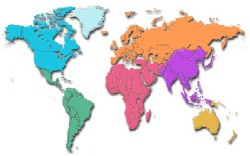Conflict diamonds are diamonds illegally traded to fund atrocities, terrorists, and brutal wars of insurgency, primarily in Central and Western Africa. Diamonds associated with this conflict now represent only a very small percentage of total worldwide diamond production (less than 1%). The percentage of conflict diamonds was as high as 10-15% in the 1990s. That percentage has been dropping as efforts continue to eliminate the flow of these stones into the marketplace.
 A major turning point occurred in 2003, when a joint government, international diamond industry and civil society initiative known as the Kimberley Process was implemented to stem the flow of conflict diamonds. The Kimberley Process Certification Scheme (KPCS) imposes requirements on diamond industry participants to certify that shipments of rough diamonds are conflict-free. In the United States, the Clean Diamond Trade Act (also introduced in 2003) enforces the Kimberley Process, which requires annual reviews of the standards, practices and procedures of any entity in the United States that issues Kimberly Process certificates for the export of rough diamonds.
A major turning point occurred in 2003, when a joint government, international diamond industry and civil society initiative known as the Kimberley Process was implemented to stem the flow of conflict diamonds. The Kimberley Process Certification Scheme (KPCS) imposes requirements on diamond industry participants to certify that shipments of rough diamonds are conflict-free. In the United States, the Clean Diamond Trade Act (also introduced in 2003) enforces the Kimberley Process, which requires annual reviews of the standards, practices and procedures of any entity in the United States that issues Kimberly Process certificates for the export of rough diamonds.
Diamond Source of Virginia, along with the entire diamond and jewelry industries, abhor the criminal activities going on in the countries involved. We are taking every possible action to ensure that no diamonds we buy or sell come from conflict areas. We only purchase diamonds from suppliers who adhere to the Kimberley Process and guarantee that their diamonds and diamond jewelry are conflict free.
It is highly unlikely that any of the diamonds owned by wholesalers we do business with came from conflict areas because of the small percentage of conflict stones in the marketplace and the adherence of our suppliers to the Kimberley Process.
 It is important to know that science and technology cannot identify the origin of a diamond. The only way to determine the exact source of a diamond is to document all movement of the rough diamond to ensure when and where mining occurred. That is difficult given that the conflict diamonds are smuggled into other countries to enter the legitimate diamond supply chain. The Kimberley Process is currently the best method of ensuring a diamond’s source is a conflict-free area.
It is important to know that science and technology cannot identify the origin of a diamond. The only way to determine the exact source of a diamond is to document all movement of the rough diamond to ensure when and where mining occurred. That is difficult given that the conflict diamonds are smuggled into other countries to enter the legitimate diamond supply chain. The Kimberley Process is currently the best method of ensuring a diamond’s source is a conflict-free area.
We, or any other retailer, cannot honestly say we know where every diamond comes from. This is just not yet possible. No science or technology exists today that can identify the origin of a polished diamond accurately or consistently. What we can say is that we only do business with the top diamond cutters and wholesalers in the country whose reputation depends on adherence to the Kimberly Process. We are diligent not to knowingly be associated in any way with conflict diamonds.
 As part of the worldwide diamond industry, we also believe that we have an obligation to the victims of conflict diamonds not to further penalize them or their families. More than a million African diamond diggers and their families live and work in absolute poverty in countries struggling to recover from the ravages of war. To boycott the diamonds from these devastated areas where mining is now legal and the hope for economic recovery, only serves to prolong the suffering. Over 60% of the world’s gem quality diamonds originate in Africa. The answer is not to avoid African diamonds but to ensure that African diamonds are conflict-free and contribute to the development of the mineworkers and their communities.
As part of the worldwide diamond industry, we also believe that we have an obligation to the victims of conflict diamonds not to further penalize them or their families. More than a million African diamond diggers and their families live and work in absolute poverty in countries struggling to recover from the ravages of war. To boycott the diamonds from these devastated areas where mining is now legal and the hope for economic recovery, only serves to prolong the suffering. Over 60% of the world’s gem quality diamonds originate in Africa. The answer is not to avoid African diamonds but to ensure that African diamonds are conflict-free and contribute to the development of the mineworkers and their communities.
